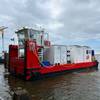In mid 2006 Wärtsilä Corporation introduced the new LJX axial water jets for the propulsion of fast vessels with promises of a 25% reduction in transom mounting flange diameter, a 10% overall reduction in weight and a 35% improvement in cavitation margin.
These benchmarks were reportedly met when the first LJX waterjet units were put through full-scale trials in July 2007. These were LJX 1500 size units of 9000 kW capacity. LJX water jets in the size range from 1800 to 22,000 kW have been ordered.
The Australian engineering consultancy firm Sinclair Knight Merz Pty Ltd (SKM) was commissioned to undertake a comprehensive test programme to map various jet performance parameters throughout the trials.
The first Wärtsilä LJX 1500 size jets are installed on the diesel-powered high-speed catamaran Natchan Rera, built by Incat Australia for Japanese owners. The 112m-long Natchen Rera sails at loaded speeds of about 40 knots and has a capacity to carry 355 cars or 450 lane metes of trucks and 193 cars.
Sea trials for Natchan Rera were completed in three days with all systems performing perfectly and exceeding best expectations. During the course of the trials while running at 100% MCR, speeds of up to 45.4 knots were averaged with 250 tons deadweight on board. Loaded with 600 tons deadweight an average speed of 41.9 knots was achieved at 100% MCR – three knots above the contracted requirement.
Robert Clifford, of the Incat group of companies, said "Wärtsilä has made a significant step forward with this new axial jet design. The delivered power is doing the job expected. The bonus is that more cavitation margin is available throughout the rev range, allowing more power to be used in maneuvering. More available power means more side thrust and this is important. The weight and space savings are also of benefit."
Full-scale test results with the LJX water jets exceeded expectations, according to the company. The available operating margins given by the cavitation behaviour of the pump are crucial for giving the vessel good maneuvering and acceleration performance with flexible operating capabilities.
Owing to the increased cavitation margin and extended operational zones, the full power of an engine can be quickly absorbed by the water jet and converted to thrust immediately, well within the new cavitation boundary and far away from thrust breakdown. The result is a smooth and rapid acceleration of the vessel. The increased cavitation margin not only makes for improved acceleration but also better maneuvering capability at speeds of less than 10 knots.
The test program undertaken by Sinclair Knight Merz comprised four major sets of tests covering jet performance; shaft torque, power and thrust; pump bowl pressure; and intake duct pressure. Measurements were undertaken during predominantly straight-line running in two sets of tests with four and three engines operating in the speed range of 500-1000 rpm. Various techniques were used for obtaining the accuracy of the measurements.
A thrust breakdown test was undertaken to determine the shaft speed at which jet performance drops at low inlet velocities owing to pump cavitation.
Measurements were also undertaken during a test with one jet operating and the speed incrementally raised until a drop in the power coefficient occurred.
A steering unit test was employed to determine the stress levels at specific locations on the steering post and arm as well as the pressures in the steering cylinders. Measurements were taken during high speed turning tests with starboard and port direction turns.
Subscribe for
Maritime Reporter E-News
Maritime Reporter E-News is the maritime industry's largest circulation and most authoritative ENews Service, delivered to your Email five times per week










